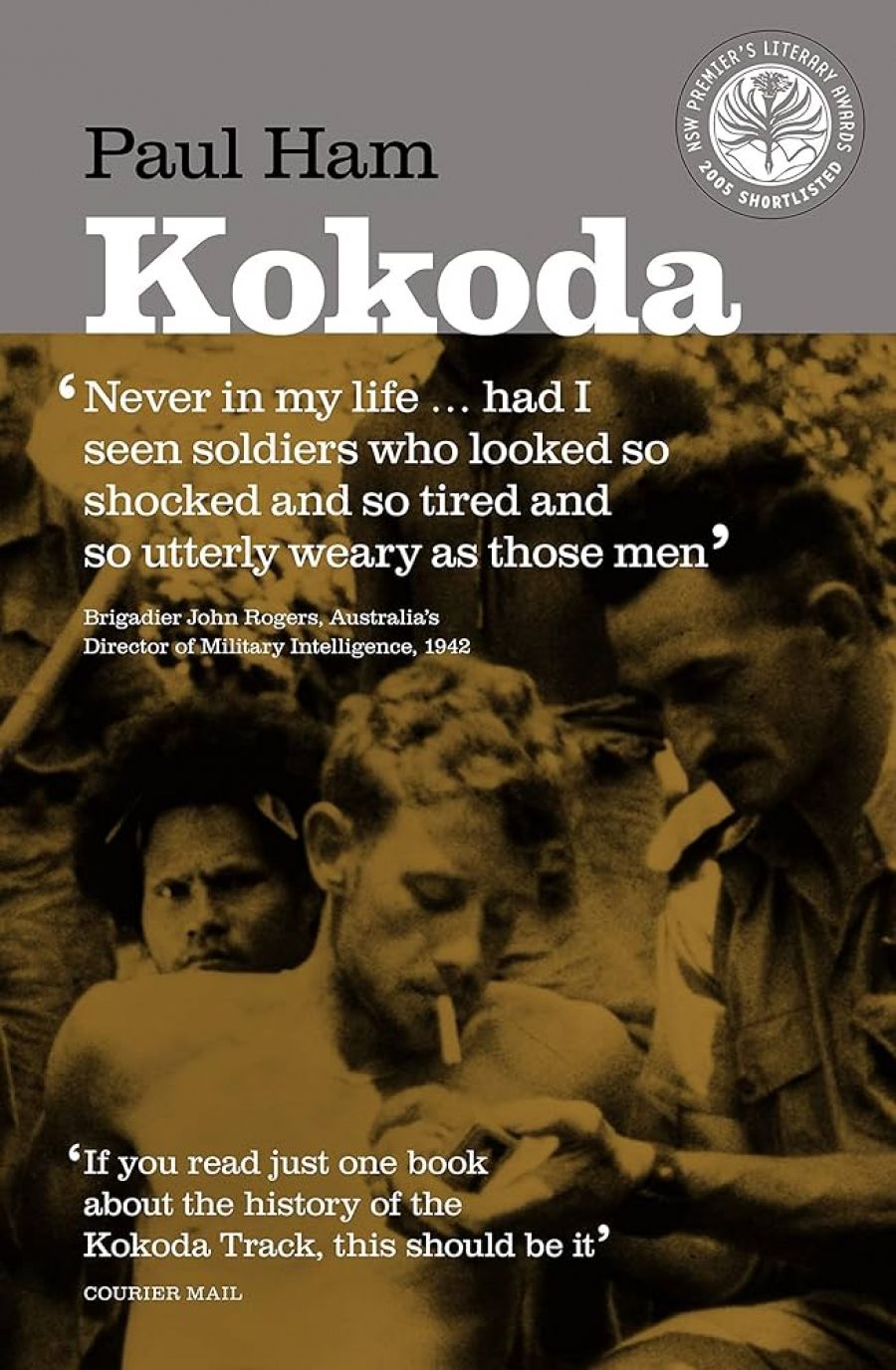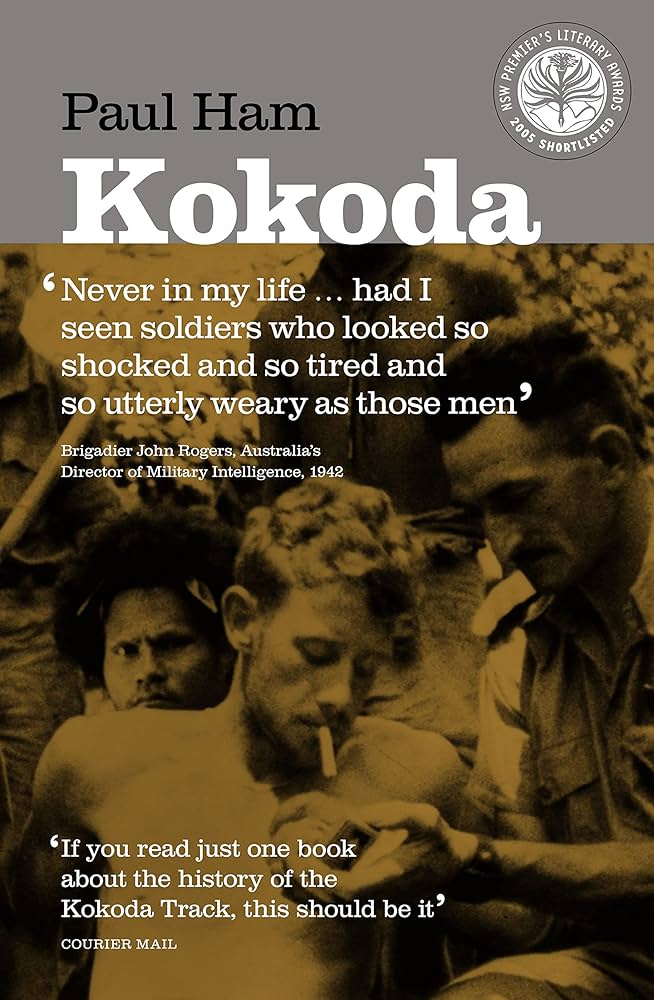
- Free Article: No
- Contents Category: Military History
- Review Article: Yes
- Article Title: Catch up to Kokoda
- Online Only: No
- Custom Highlight Text:
In Dudley McCarthy’s volume in the Australian official history of World War II, subtitled Kokoda to Wau (1959), there is a wonderfully evocative passage that sets the fighting in Papua New Guinea in context:
- Book 1 Title: Kokoda
- Book 1 Biblio: HarperCollins, $45 hb, 602 pp
- Book 1 Cover Small (400 x 600):

- Book 1 Cover (800 x 1200):

In it [the campaign] there is none of the wild, heart thrilling drama of great bodies of men meeting on wide battlefields in the shocks of massed encounter. Instead, for the most part, it is the story of small groups of men, infinitesimally small against the mountains in which they fought, who killed one another in stealthy and isolated encounters beside the tracks which were life to all of them; of warfare in which men first conquered the country and then allied themselves with it and then killed or died in the midst of a great loneliness.
Thus, although there have been more than a dozen books since on the Kokoda Track campaign – including this well-researched, well-written work by Paul Ham, a journalist by training – all of these authors have had to work within the realities of McCarthy’s psychological and prescriptive template: how to get the logistics working to supply the troops and keep them from starving; how, before the age of the helicopter, to evacuate the wounded so that they did not die in the process, as many did; how to confront an experienced Japanese enemy hiding behind the next tree; and, above all, how to overcome the fear and strangeness of the jungle and the mountains that were alien to most of them.
Moreover, as telling as these operational difficulties were, there was the overarching disjunction in the way the Allied leadership functioned. It was led, not exactly from the front, by General Douglas MacArthur, the Commander-in-Chief South-West Pacific Area, who, although he knew in advance from Ultra sources (the cracking by Allied signals intelligence of key Japanese codes and ciphers) that the Japanese planned to attack Port Moresby over the mountains, was actually in the process of moving his headquarters from Melbourne to Brisbane when the Japanese attacked. Thus, the Japanese South Seas Force gained the initiative, which it did not lose until in sight of Port Moresby.
Having fumbled the response at the outset, MacArthur, to use the jargon, was constantly playing ‘catch-up’, which set the pattern for much of the campaign that followed. Nor did MacArthur’s strangely layered orders chain help matters. It was prone to panic and because almost no senior officer in the chain ever got far enough forward to recognise the extent of the difficulties faced by the troops, the nature of the fighting was totally misunderstood. It led, as everyone now knows, to a command crisis that was aggravated by MacArthur’s sudden realisation that he could not afford a further failure, having not long before been ignominiously ejected from the Philippines. In consequence, he sent his principal land commander, General Thomas Blamey (whose military career was equally in the balance), to New Guinea to ‘energise’ the situation, well recognising that Blamey and a string of lesser Australian commanders were more expendable than he was. Not surprisingly, this led to a confrontation with the able but prickly Lieutenant-General Sydney Rowell, the man on the spot, whom Blamey proceeded to remove from command, even as the tactical situation was in the process of reversing itself as the Japanese thrust ran out of steam.
The author handles this and other high-level disputes lucidly and well. Indeed, the whole book reflects a sound approach. At 600 pages, plus maps and photographs, this is a big tome. Again, Ham has chosen to deal not only with the confused but heroic fighting along the track itself but also with the concurrent campaign at Milne Bay – the first occasion in the Pacific war when a Japanese amphibious landing was defeated and turned back – and then forwards to the equally bitter bridgehead battles at Buna, Gona and Sanananda, on the north coast.
The descriptions of the actual fighting are handled competently, and with empathy for the unbelievable difficulties and sacrifices of the troops. The author divides the book into no less than fifty-seven short, snappy chapters that have the quality of a series of carefully constructed essays on subjects as diverse as Intelligence, Chocos (the Militia), John Curtin, MacArthur, Blamey and Rowell, Madness and Mosquitoes. He has made extensive use of the massive collection of primary sources in the Australian War Memorial, as well as many interviews with participants on both sides. A feature of the book is the way Ham alternates the Australian troops’ eye-witness accounts of severe actions with the equal but opposite accounts by the Japanese of the same actions. The result is a succession of battle descriptions, strong on detail and facts. Indeed, even when issues and incidents are relatively well known, his writing gives them new perspective.
One such is Blamey’s now infamous speech at the Koitaki Cricket Ground where, instead of praising the veterans of Maroubra Force for their stubborn fighting withdrawal back over the mountains from Kokoda – during which they inflicted many more casualties on the Japanese than they themselves received, and in the process wore down the momentum of the Japanese thrust – he admonished them. His language on the day has been variously described. It was not recorded, but among the interpretations that have been handed down, he is alleged to have said: ‘Remember. It is not the man with the gun that gets shot; it’s the rabbit that is running away.’ It was an inaccurate and unforgivable slur that many men never forgot. Dr Brian Honner, son of Lieutenant-Colonel Ralph Honner, the Commanding Officer of the 39th Battalion and one of the genuine heroes of the campaign, stated that: ‘My father always said that many men knew they were likely to be killed in those attacks, but accepted their fate and charged towards the enemy, because for months they had been incensed by Blamey’s Koitaki address.’ Perhaps Blamey said it to ginger the troops, who did not believe that they needed to be ‘gingered’. What they needed was enlightened senior leadership to help them fight the Japanese.
There are some errors. Veterans of Australia’s Machine Gun Battalions will be dismayed to learn that their beloved Vickers was a ‘light machine gun’. Its official title was ‘medium machine gun’, but some old sweats I know believe that it was probably the finest sustained-fire machine gun ever, and deserves still to be in service. The Stuart (or ‘Honey’) was an American Light Tank, not Australian, although, at places such as Buna and Sanananda, it was crewed by Australian tankers. Some of the author’s swipes at officers, for example at Brigadier Selwyn Porter, generally miss their mark.
More serious is the author’s contention that the Australian Chiefs of Staff were of a mind in opposing Prime Minister Curtin’s strong position that the AIF divisions from the Middle East – the 6th, 7th and later the 9th – must come back for the defence of Australia, instead agreeing with Churchill’s firmly voiced opinion that some should be diverted to Burma. The opposite was the case. Lieutenant-General Vernon Sturdee, the Army’s Chief of the General Staff, threatened resignation if the troops were not returned to Australia. In fact, it was Sturdee’s strongly argued paper that Curtin – who was a brilliant leader but no strategist – used to advantage to confront Churchill, who was not used to being spoken to like that by some obscure Dominion prime minister.
In summary, this is a good book, but, paradoxically, its very quality begs the question: how many more books do we need to convince ourselves that Australian troops, airmen and sailors fought valiantly and well during the New Guinea campaign? We all salute them for their stead-fastness and courage under wretched conditions. However, for this reviewer, the focus is being kept too narrow, particularly when it is recognised that despite the fierce nature of the Japanese thrust across the mountains, their high command committed more than twice as many troops, and even more formidable naval and air assets, in order to regain the initiative they had lost to Admiral Halsey’s command in the adjacent Solomon Islands, especially Guadalcanal. Both campaigns lasted six months almost to the day, and in almost exactly the same time frame. In the latter case, the US Navy fought no less than seven major surface actions and many lesser ones, during which both they and the Japanese each lost twenty-four major combat vessels, including two Japanese battleships and two American aircraft carriers. The Royal Australian Navy lost the cruiser Canberra. Surely we need to acknowledge that it was the cumulative effect of both campaigns that seized the initiative from which the Japanese never recovered, and that, when describing one, we need also to acknowledge the importance of the other.


Comments powered by CComment